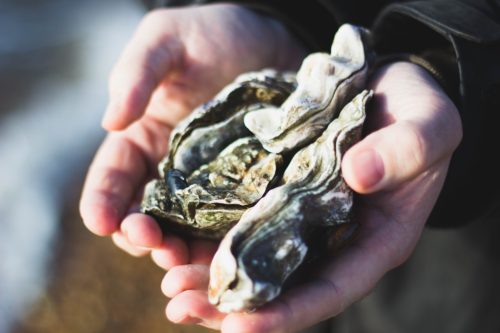June 2, 2018Oyster Facts & Information

Are oysters safe to eat?
Oysters harvested from approved waters, packed under sanitary conditions, and properly refrigerated are usually safe for raw consumption by healthy individuals. Cooking oysters to an internal temperature of 140o F or greater for 4-6 minutes destroys the common microorganisms of public health concern. Oysters can be enjoyed in a variety of cooked preparations including steamed, stewed, roasted, baked, broiled, sauteed, poached, and fried.
Consumption of raw or partially cooked oysters creates a risk of serious illness to certain individuals with predisposed medical conditions. These include:
- Liver Disease
- Chronic alcohol abuse
- Cancer (especially if taking anti-cancer drugs or radiation treatment)
- Diabetes
- Inflammatory bowel and stomach diseases
- Steroid dependency (as used for conditions such as chronic obstructive pulmonary disease, etc.)
- Achlorhydria (a condition in which the normal acidity of the stomach is reduced or absent)
- AIDS
It is highly recommended that individuals with these conditions avoid eating raw or partially cooked oysters.
What is the nutritional value of oysters?
Raw oysters have a protein content of about 9 percent and a fat content of less than 2 percent. One-half pound of raw oysters contains about 150 calories. The cholesterol content of oysters is 50 milligrams/100 grams of meat, and the sodium content is 109 milligrams/100 grams. Oysters are also very high in iron content.
What are visible characteristics of quality oysters?
Oysters in the shell (shellstock) should not gape and should close readily when tapped. If the shell does not close tightly or the oyster meat is dry when the shell is open, the product should be discarded. Avoid eating oysters when their shell is broken or damaged. The meat of shucked oysters is usually a creamy tan color, plump, and should smell fresh and mild.
Should oysters be eaten only in the months with an “R”?
Oysters may be eaten safely during any time of the year. However, oysters are highly perishable and can spoil quickly in the hot summer months if they are not properly refrigerated. Oysters can be kept fresh longer by utilizing today’s improved temperature controls and distribution capabilities.
How should oysters be handled and stored?
Shellstock should be washed to remove excess debris prior to storage in well ventilated, refrigerated areas. The temperature of refrigeration units where oysters are stored should be between 34o F and 45o F. Shellstock should never be stored in air-tight containers. Shucked oysters also require refrigeration, and consumers should closely adhere to the recommended expiration date on containers. Raw and cooked oysters should be handled separately to avoid possible cross contamination. Work space and utensils should be thoroughly cleaned between preparations.
Can oysters be frozen?
Oysters may be frozen, but once thawed, the texture of the meat, becomes softer and the oysters are generally not suitable for raw consumption. Frozen oysters, however, are quite acceptable when they are cooked. Oysters should be frozen quickly at a temperature of 0o F or lower. Rapid freezing results in smaller ice crystal formation and less tissue damage. Freezer bags and plastic containers with lids are preferred for freezing. Oysters should be frozen immersed in their liquor or water and excess air should be expelled from the containers to provide protection from freezer burn. In storage, frozen oysters should be maintained at 0o F or lower. Oysters should always be thawed in the refrigerator and at least 24 hours should be allowed for thawing. Oysters should never be refrozen.
What do color variations in oysters mean?
Although oysters are usually creamy tan, their diet or certain environmental conditions may cause them to take on other colorations. Oysters which have filtered certain microscopic organisms as food may have a reddish or greenish coloration. Pigments from these microorganisms may dissolve in water and are sometimes seen in the liquor. These discolorations are harmless and disappear when the product is cooked. However, a pink discoloration in oysters accompanied by an offensive odor is caused by the presence of yeast. These oysters should be discarded.
Does eating oysters really help one’s sex life?
Since Roman times many people have believed oysters to be an aphrodisiac. There is no scientific basis for this belief. However, therapists treating patients for sexual disorders often recommended eating oysters due to their high iron content.
Angels on Horseback
- 1 jar (12 ounces) fresh oysters, drained
- ½ teaspoon lemon pepper
- 2 tablespoons chopped parsley 10 slices bacon, cut in thirds
Place an oyster on each piece of bacon and sprinkle with parsley and lemon pepper. Wrap bacon around oyster and secure with a toothpick. Place oysters on a broiler pan. Broil about 4 inches from source of heat for 8 to 10 minutes or until bacon is crisp. Turn carefully. Broil 4 to 5 minutes longer or until bacon is crisp. Makes approximately 30 hors d’oeuvres.
Consumer Information Message
As in the case with consuming other raw animal protein products, there is a risk associated with consuming raw oysters, clams, and mussels. If you suffer from chronic illness of the liver, stomach, or blood, or have immune disorders, do not eat these products raw.
